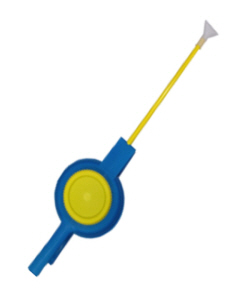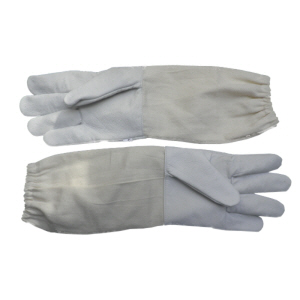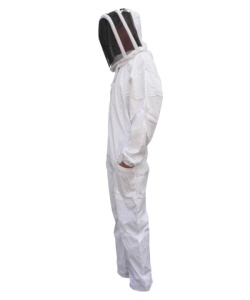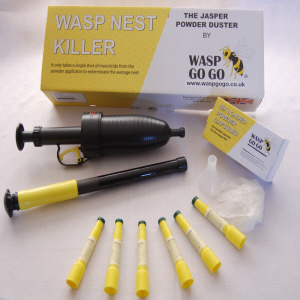Information about Wasps - Solitary Wasps
The nesting habits of solitary wasps are more diverse than those of social wasps. Mud daubers and pollen wasps construct mud cells in sheltered places typically on the side of walls. Potter wasps similarly build vase-like nests from mud, often with multiple cells, attached to the twigs of trees or against walls. Most other predatory wasps burrow into soil or into plant stems, and a few do not build nests at all and prefer naturally occurring cavities, such as small holes in wood. A single egg is laid in each cell, which is sealed thereafter, so there is no interaction between the larvae and the adults, unlike in social wasps. In some species, male eggs are selectively placed on smaller prey, leading to males being generally smaller than females.
Information about Wasps- Social Caste Structure
Not all social wasps have castes that are physically different in size and structure. In many polistine paper wasps and stenogastrines, for example, the castes of females are determined behaviorally, through dominance interactions, rather than having caste predetermined. All female wasps are potentially capable of becoming a colony’s queen and this process is often determined by which female successfully lays eggs first and begins construction of the nest. Evidence suggests that females compete amongst each other by eating the eggs of other rival females. The queen may, in some cases, simply be the female that can eat the largest volume of eggs while ensuring that her own eggs survive (often achieved by laying the most). This process theoretically determines the strongest and most reproductively capable female and selects her as the queen. Once the first eggs have hatched, the subordinate females stop laying eggs and instead forage for the new queen and feed the young; that is, the competition largely ends, with the losers becoming workers, though if the dominant female dies, a new hierarchy may be established with a former worker acting as the replacement queen. Polistine nests are considerably smaller than many other social wasp nests, typically housing only around 250 wasps, compared to the several thousand common with yellowjackets, and stenogastrines have the smallest colonies of all, rarely with more than a dozen wasps in a mature colony.
Information about Wasps Reproductive Cycle
Wasps do not reproduce via mating flights like bees. Instead social wasps reproduce between a fertile queen and male wasp; in some cases queens may be fertilized by the sperm of several males. After successfully mating, the male’s sperm cells are stored in a tightly packed ball inside the queen. The sperm cells are kept stored in a dormant state until they are needed the following spring. At a certain time of the year (often around autumn), the bulk of the wasp colony dies away, leaving only the young mated queens alive. During this time they leave the nest and find a suitable area to hibernate for the winter.
First stage
After emerging from hibernation during early summer, the young queens search for a suitable nesting site. Upon finding an area for their colony, the queen constructs a basic wood fiber nest roughly the size of a walnut into which she will begin to lay eggs.
Second stage
The sperm that was stored earlier and kept dormant over winter is now used to fertilize the eggs being laid. The storage of sperm inside the queen allows her to lay a considerable number of fertilized eggs without the need for repeated mating with a male wasp. For this reason a single queen is capable of building an entire colony by herself. The queen initially raises the first several sets of wasp eggs until enough sterile female workers exist to maintain the offspring without her assistance. All of the eggs produced at this time are sterile female workers who will begin to construct a more elaborate nest around their queen as they grow in number.
Third stage
By this time the nest size has expanded considerably and now numbers between several hundred and several thousand wasps. Towards the end of the summer, the queen begins to run out of stored sperm to fertilize more eggs. These eggs develop into fertile males and fertile female queens. The male drones then fly out of the nest and find a mate thus perpetuating the wasp reproductive cycle. In most species of social wasp the young queens mate in the vicinity of their home nest and do not travel like their male counterparts do. The young queens will then leave the colony to hibernate for the winter once the other worker wasps and founder queen have started to die off. After successfully mating with a young queen, the male drones die off as well. Generally, young queens and drones from the same nest do not mate with each other; this ensures more genetic variation within wasp populations, especially considering that all members of the colony are theoretically the direct genetic descendants of the founder queen and a single male drone. In practice, however, colonies can sometimes consist of the offspring of several male drones. Wasp queens generally (but not always) create new nests each year, probably because the weak construction of most nests render them uninhabitable after the winter.
Unlike honey bee queens, wasp queens typically live for only one year. Also queen wasps do not organize their colony or have any raised status and hierarchical power within the social structure. They are more simply the reproductive element of the colony and the initial builder of the nest in those species which construct nests.





